Regulation of KATP channel activity by diazoxide and MgADP. Distinct functions of the two nucleotide binding folds of the sulfonylurea receptor
- PMID: 9382893
- PMCID: PMC2229399
- DOI: 10.1085/jgp.110.6.643
Regulation of KATP channel activity by diazoxide and MgADP. Distinct functions of the two nucleotide binding folds of the sulfonylurea receptor
Abstract
KATP channels were reconstituted in COSm6 cells by coexpression of the sulfonylurea receptor SUR1 and the inward rectifier potassium channel Kir6.2. The role of the two nucleotide binding folds of SUR1 in regulation of KATP channel activity by nucleotides and diazoxide was investigated. Mutations in the linker region and the Walker B motif (Walker, J.E., M.J. Saraste, M.J. Runswick, and N.J. Gay. 1982. EMBO [Eur. Mol. Biol. Organ.] J. 1:945-951) of the second nucleotide binding fold, including G1479D, G1479R, G1485D, G1485R, Q1486H, and D1506A, all abolished stimulation by MgADP and diazoxide, with the exception of G1479R, which showed a small stimulatory response to diazoxide. Analogous mutations in the first nucleotide binding fold, including G827D, G827R, and Q834H, were still stimulated by diazoxide and MgADP, but with altered kinetics compared with the wild-type channel. None of the mutations altered the sensitivity of the channel to inhibition by ATP4-. We propose a model in which SUR1 sensitizes the KATP channel to ATP inhibition, and nucleotide hydrolysis at the nucleotide binding folds blocks this effect. MgADP and diazoxide are proposed to stabilize this desensitized state of the channel, and mutations at the nucleotide binding folds alter the response of channels to MgADP and diazoxide by altering nucleotide hydrolysis rates or the coupling of hydrolysis to channel activation.
Figures
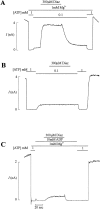
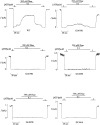
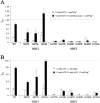
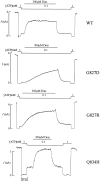
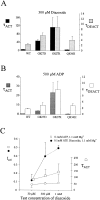




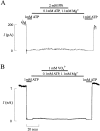
Similar articles
-
Involvement of the n-terminus of Kir6.2 in coupling to the sulphonylurea receptor.J Physiol. 1999 Jul 15;518 ( Pt 2)(Pt 2):325-36. doi: 10.1111/j.1469-7793.1999.0325p.x. J Physiol. 1999. PMID: 10381582 Free PMC article.
-
Altered functional properties of KATP channel conferred by a novel splice variant of SUR1.J Physiol. 1999 Dec 1;521 Pt 2(Pt 2):337-50. doi: 10.1111/j.1469-7793.1999.00337.x. J Physiol. 1999. PMID: 10581306 Free PMC article.
-
Cooperative binding of ATP and MgADP in the sulfonylurea receptor is modulated by glibenclamide.Proc Natl Acad Sci U S A. 1999 Feb 16;96(4):1268-72. doi: 10.1073/pnas.96.4.1268. Proc Natl Acad Sci U S A. 1999. PMID: 9990013 Free PMC article.
-
[Activation of ATP-sensitive K+ channels by ADP and K+ channel openers: homology model of sulfonylurea receptor carboxyl-termini].Nihon Yakurigaku Zasshi. 2001 Sep;118(3):177-86. doi: 10.1254/fpj.118.177. Nihon Yakurigaku Zasshi. 2001. PMID: 11577458 Review. Japanese.
-
Molecular biology of adenosine triphosphate-sensitive potassium channels.Endocr Rev. 1999 Apr;20(2):101-35. doi: 10.1210/edrv.20.2.0361. Endocr Rev. 1999. PMID: 10204114 Review.
Cited by
-
Interaction between mutations in the slide helix of Kir6.2 associated with neonatal diabetes and neurological symptoms.Hum Mol Genet. 2010 Mar 15;19(6):963-72. doi: 10.1093/hmg/ddp554. Epub 2009 Dec 18. Hum Mol Genet. 2010. PMID: 20022885 Free PMC article.
-
Pyridine nucleotide regulation of the KATP channel Kir6.2/SUR1 expressed in Xenopus oocytes.J Physiol. 2003 Jul 15;550(Pt 2):357-63. doi: 10.1113/jphysiol.2003.041715. Epub 2003 May 23. J Physiol. 2003. PMID: 12766240 Free PMC article.
-
Intracellular nucleotide-mediated gating of SUR/Kir6.0 complex potassium channels expressed in a mammalian cell line and its modification by pinacidil.J Physiol. 1998 Sep 15;511 ( Pt 3)(Pt 3):663-74. doi: 10.1111/j.1469-7793.1998.663bg.x. J Physiol. 1998. PMID: 9714850 Free PMC article.
-
Activation of the K(ATP) channel by Mg-nucleotide interaction with SUR1.J Gen Physiol. 2010 Oct;136(4):389-405. doi: 10.1085/jgp.201010475. J Gen Physiol. 2010. PMID: 20876358 Free PMC article.
-
Engineered interaction between SUR1 and Kir6.2 that enhances ATP sensitivity in KATP channels.J Gen Physiol. 2012 Aug;140(2):175-87. doi: 10.1085/jgp.201210803. Epub 2012 Jul 16. J Gen Physiol. 2012. PMID: 22802363 Free PMC article.
References
-
- Aguilar-Bryan L, Nichols CG, Wechsler SW, Clement JP, IV, Boyd AE, III, Gonzalez G, Herrera H, Sosa, Nguy K, Bryan J, Nelson DA. The β cell high affinity sulfonylurea receptor: a regulator of insulin secretion. Science. 1995;268:423–426. - PubMed
-
- Anderson MP, Welsh MJ. Regulation by ATP and ADP of CFTR chloride channels that contain mutant nucleotide-binding domains. Science. 1992;257:1701–1704. - PubMed
-
- Ashcroft FM. Adenosine 5′-triphosphate-sensitive potassium channels. Annu Rev Neurosci. 1988;11:97–118. - PubMed
-
- Baukrowitz T, Hwang TC, Nairn AC, Gadsby DC. Coupling of CFTR Cl−channel gating to an ATP hydrolysis cycle. Neuron. 1994;12:473–482. - PubMed
Publication types
MeSH terms
Substances
Grants and funding
LinkOut - more resources
Full Text Sources
Other Literature Sources
Medical

